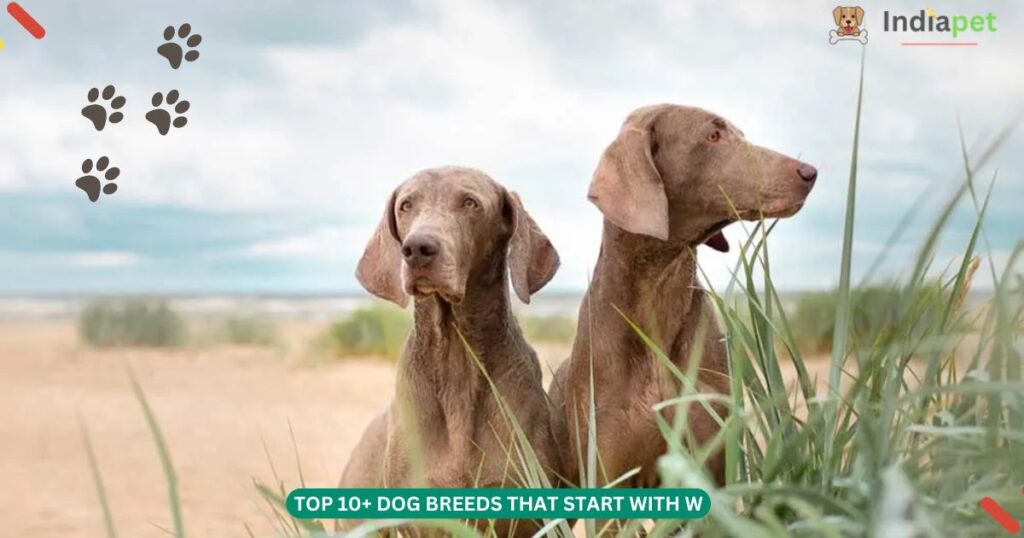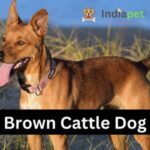Welcome to the world of dog breeds that start with W! Today, we’re highlighting dogs that begin with W, from the famous to the unknown.
Let’s explore these top 10 wonderful dog breeds that start with ‘W’
Top 10+ Dog Breeds that start with W
- Weimaraner
- West Highland White Terrier
- Whippet
- Wire Fox Terrier
- Welsh Terrier
- Welsh Springer Spaniel
- Wirehaired Vizsla
- West Siberian Laika
- Wetterhoun
Dog Breeds that start with W
Weimaraner
Weimaraner dogs are known for their affection and loyalty towards their family. They are a German hunting dog of medium to large size whose history goes back at least to the 19th century.
The Weimaraner is of medium to large size: bitches about 57 to 65 cm; dogs stand some 59 to 70 cm at the withers, and weights are in the range of 30–40 kg for dogs and 25–35 kg for bitches.
- Origin: Germany
- Size: These are large dogs
- Breed group: Gundog
- Lifespan: 10 to 13 years.
- Coat: The Weimaraner has a short, smooth, silver-grey coat.
- Temperament: gentle and affectionate temperament.
- Exercise needs: Needs at least 30 to 60 minutes of exercise per day.
- Training: Easy to train with positive reinforcement methods.

West Highland White Terrier
This breed is intelligent, learns quickly, and gets along well with children. It is commonly known as the Westie and has an average life expectancy of 13-15 years. The West Highland White Terrier can be a well-behaved and adaptable family dog.
- Origin: Scotland
- Size: 15-20 pounds; 10-11 inches tall
- Coat: Dense, harsh, white double coat
- Personality: Energetic, affectionate, confident
- Intelligence: Quick learners, sometimes stubborn
- Exercise Needs: Daily walks, playtime, mental stimulation
- Diet: Balanced diet tailored to size, age, activity level
- Health Concerns: Allergies, hip dysplasia, patellar luxation
- Grooming: Regular brushing, occasional bathing, professional trimming
- Lifespan: 12-16 years
- Compatibility: Good with children, adaptable to various living situations

Whippet
Developed in the 19th century, they are gentle, patient, tolerant and affectionate dogs. Working people in northern England popularized competitions to see whose Whippet could kill the most rabbits or rats or whose Whippet was the fastest.
- Coat: Short, smooth, and fine coat that can be any colour or combination of colours.
- Temperament: Gentle, affectionate, and playful
- Exercise needs: Moderate to high
- Training needs: Easy to train
- Origin: England
- Size: Medium
- Breed Group: Hound
- Lifespan: 12-15 years
- Health: Whippets are generally healthy dogs

Wirehaired Pointing Griffon
- Origin: Developed in Europe, particularly the Netherlands and France
- Purpose: Versatile hunting dog skilled in pointing and retrieving game on land and in water
- Size: Medium-sized, with males typically weighing 50-60 pounds (23-27 kg) and females slightly less
- Lifespan: Approximately 12-14 years
- Grooming: Regular brushing and occasional hand-stripping to maintain coat texture; minimal shedding
- Living Conditions: Adaptable but prefers homes with access to outdoor spaces.
- Socialization: Early socialization is important to ensure good behaviour with other animals and people
- Special Traits: Excellent hunting companion with a keen sense of smell and strong work ethic
- Height: 20-24 inches (51-61 cm) at the shoulder
- Coat: Harsh, wiry, and weather-resistant coat; usually grey with brown markings
- Temperament: Friendly, affectionate, and loyal; good with families and other pets
- Exercise Needs: High energy level; requires regular physical activity and mental stimulation
- Training: Intelligent and eager to please; responds well to positive reinforcement training
- Health: Generally healthy; prone to hip dysplasia, elbow dysplasia, and eye conditions

Wire Fox Terrier
Wire Fox terriers can be traced back to at least the 1700s in Britain, He might be small, but the short-backed, muscular Wire Fox Terrier exudes strength. Adult male dogs are 39cm tall or under and weigh about 8kg, and females are slightly smaller. They typically live 12–15 years.

Welsh Terrier
- Origin: Wales, United Kingdom
- Purpose: Originally bred for hunting foxes, rodents, and badgers
- Size: Small to medium-sized, weighing 20-22 pounds (9-10 kg)
- Height: 15-15.5 inches (38-39 cm) at the shoulder
- Coat: Dense, wiry, and weather-resistant; typically black and tan
- Temperament: Energetic, friendly, and intelligent; good with families and other pets
- Exercise Needs: High energy level; requires regular exercise and mental stimulation
- Training: Intelligent and independent; responds well to positive reinforcement training
- Health: Generally healthy; prone to hip dysplasia, allergies, and eye conditions
- Lifespan: Approximately 12-15 years
- Living Conditions: Adaptable to various living conditions; thrives in homes with access to outdoor spaces
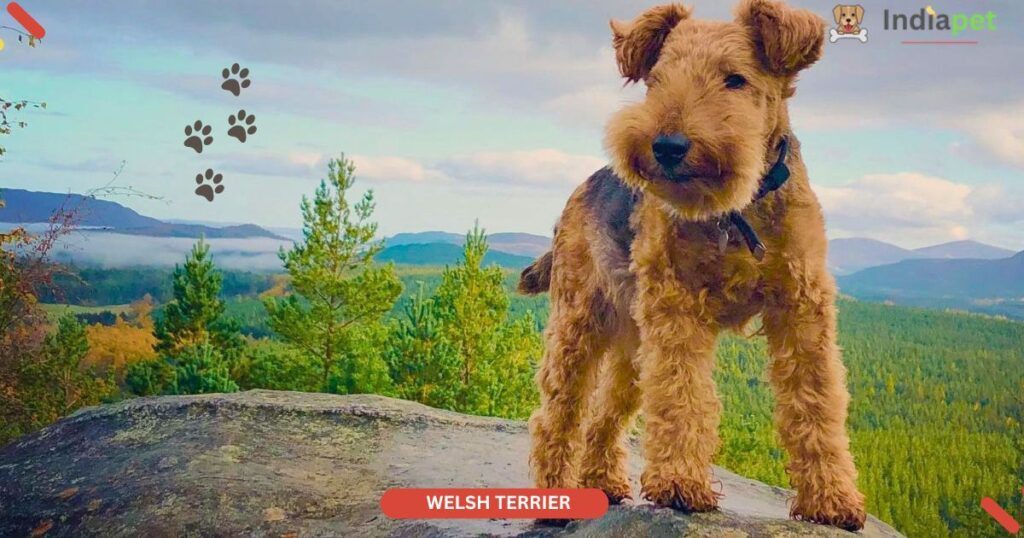
Welsh Springer Spaniel
Spaniels have white skin, and if they have any spots, they are usually red. John Caius wrote in 1570 that the origin of the Welsh Springer Spaniel is unknown, and they are a medium-sized sporting dog breed.
- Origin: Wales
- Size: Female: 17-18 inches (43-46 cm) tall at the shoulder, 35-40 pounds (16-18 kg); Male: 18-19 inches (46-48 cm) tall at the shoulder, 40-45 pounds (18-20 kg).
- Breed group: Sporting
- Lifespan: 12-15 years
- Exercise needs: High
- Training: Requires early and consistent training
- Coat: A long, silky coat that is red and white in colour
- Temperament: Friendly, outgoing, affectionate, and playful
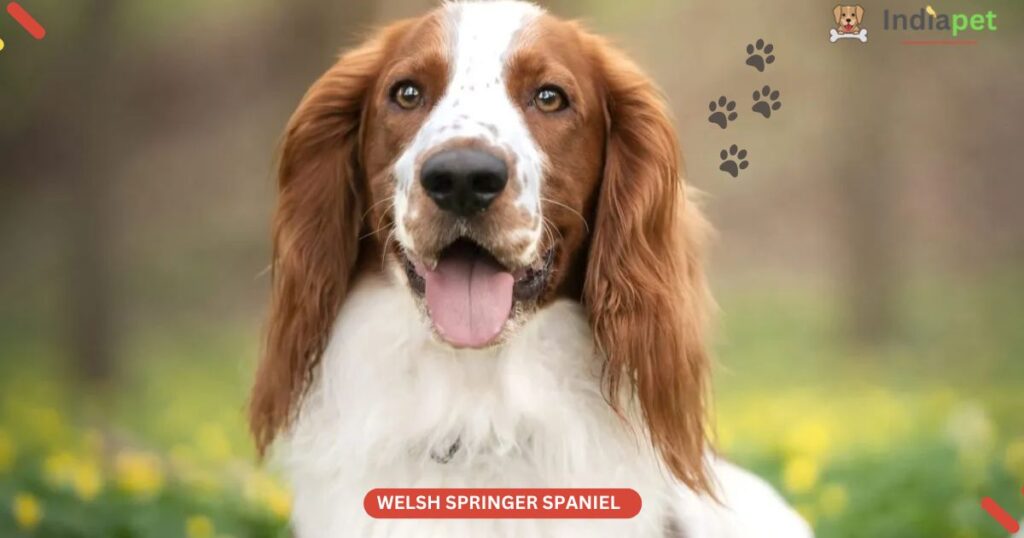
Wirehaired Vizsla
Wirehaired Vizsla dogs are generally lively but gentle, strong athletes, and an average-sized pointing breed.
- Coat: Short, wiry, thick
- Coat colour: Golden rust
- Life span: 12 to 14 years
- Temperament: Loyal, affectionate, gentle
- Hypoallergenic: Yes
- Origin: Hungary
- Group: Sporting
- Height: 21.5 to 23 inches (females), 23 to 25 inches (males)
- Weight: 45 to 55 pounds (females), 55 to 65 pounds (males)

West Siberian Laika
- Origin: Siberia, Russia
- Purpose: Traditionally used for hunting, including large game like moose and wild boar, as well as smaller animals and birds
- Size: Medium to large-sized, with males typically weighing 40-55 pounds (18-25 kg) and females slightly less
- Height: 21-24 inches (53-61 cm) at the shoulder
- Coat: Dense, double coat with a thick undercoat; colours include white, grey, red, and various combinations.
- Exercise Needs: High energy level; requires regular exercise and mental stimulation
- Training: Intelligent but can be stubborn; responds best to consistent, positive reinforcement training
- Health: Generally healthy; prone to hip dysplasia and certain genetic conditions
- Lifespan: Approximately 12-15 years
- Grooming: Regular brushing to manage shedding; more frequent grooming during seasonal shedding periods
- Living Conditions: Best suited for homes with ample outdoor space.
- Socialization: Early socialization is important to ensure good behaviour with other animals and people
- Special Traits: Strong hunting instinct and excellent sense of smell.
- Temperament: Energetic, intelligent, and independent; loyal to family but can be reserved with strangers
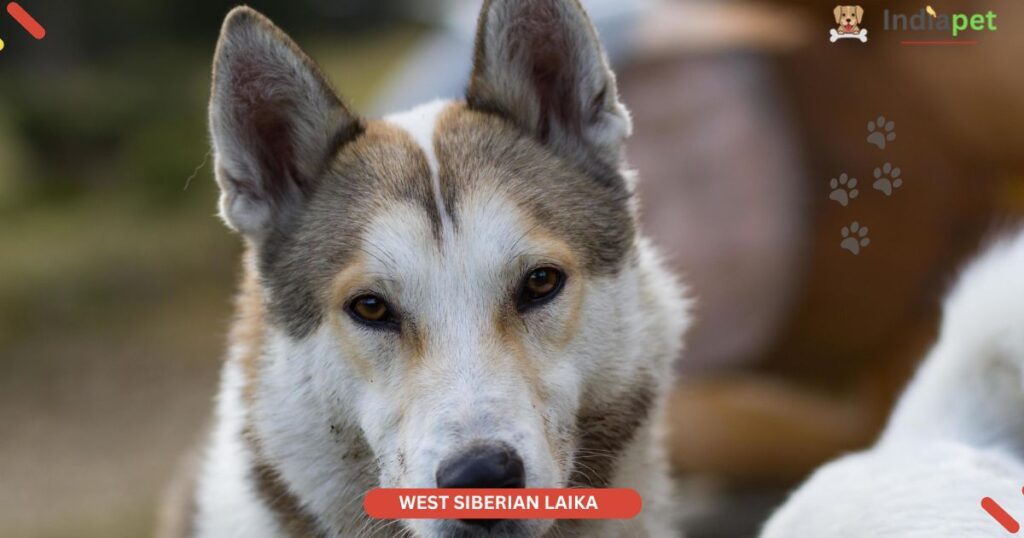
Wetterhoun
- Origin: Friesland, Netherlands
- Purpose: Traditionally used as a hunting and water dog, skilled in retrieving waterfowl and hunting small game
- Size: Medium-sized, with males typically weighing 33-44 pounds (15-20 kg) and females slightly less
- Height: 21-23 inches (53-59 cm) at the shoulder
- Coat: Thick, curly, and waterproof coat; colours include black, liver, and combinations with white
- Temperament: Loyal, intelligent, and protective; can be reserved with strangers but affectionate with family
- Exercise Needs: High energy level; requires regular exercise and mental stimulation
- Training: Can be stubborn but responds well to consistent, positive reinforcement training
- Health: Generally healthy; prone to hip dysplasia, elbow dysplasia, and eye issues
- Lifespan: Approximately 12-14 years
- Grooming: Regular brushing to prevent matting; occasional bathing
- Living Conditions: Adaptable to various living conditions but thrives in homes with access to outdoor spaces
- Socialization: Early socialization is crucial to prevent shyness or aggression towards strangers and other animals.

